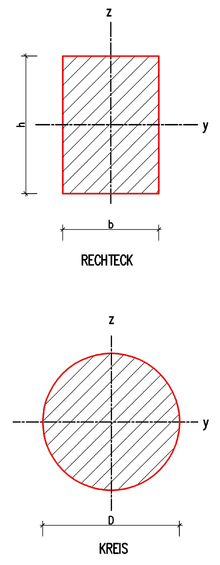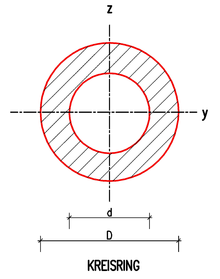Moment of resistance
In technical mechanics, the moment of resistance is a quantity derived solely from the geometry (shape and dimensions) of a cross-section of a beam . It is a measure of the resistance a beam offers to the development of internal stresses when under load .
- When it comes to bending , the term axial or bending moment of resistance is used
- when twisting ( torsion ) one speaks of the polar moment of resistance or torsional moment of resistance .
The section modulus of resistance has a simple geometric relationship with the area moment of inertia , which is used to calculate the deformation of a beam under load when dimensioning the section (see also stiffness ). Section modulus and area moment of inertia are, depending on the typical dimensions of geometrically simple surfaces and standardized material profiles (e.g. steel profiles ), contained in general technical manuals, often in common tables.
Basics
With forces perpendicular to a reference axis, the force wants to bend the body or - if a lever is available - rotate it around this axis. If the rotation is prevented by clamping , a bending or torsional moment arises . Resistance torques are always calculated in relation to the respective torque axis.
calculation
The section modulus is defined as:
With
- the area moment of inertia
- the maximum vertical distance between the edge fiber (cross-sectional edge) and the neutral (tension-free) fiber . In the extreme fiber of the maximum component are contact stresses (see below: application).
The unit of the section modulus is .
For symmetrical cross-sections, the moments of resistance in the edge fibers parallel to the axis of symmetry are the same. Therefore, the tensions in these fibers are the same when the bending forces act perpendicular to this axis of symmetry.
application
In the case of a purely elastic deformation, the maximum stresses occurring in the edge fibers are determined by:
With
- : maximum normal stress
- : Bending moment around the reference axis
- : axial geometrical moment of inertia .
- : maximum vertical distance between the edge fiber and the neutral fiber
and through:
With
- : maximum tangential stress ( shear stress )
- : Torsional moment around the reference axis
- : polar area moment of inertia .
- : maximum vertical distance between the edge fiber and the neutral fiber
The maximum stresses that are determined in this way are compared with the stresses ( strength ) that the material can tolerate in order to check whether the beam fails .
Examples
Note: For non-circular cross-sections, the polar moments of resistance can be calculated. However, they are of little practical importance, since the distribution of the torsional stress for such cross-sections is subject to different laws.
- For a rectangle with width b parallel to the y-axis and height h is the section modulus with respect to the horizontal axis
- For the same rectangle is the section modulus with respect to the vertical axis
- for a square with side length a = b = h the section modulus is simplified to
- For a circle with a diameter
- For a circular ring with outside diameter D and inside diameter d is the section modulus
- For a trapezoid with the base B parallel to the y-axis and the height h
- Hollow profile (rectangular tube)
- For a rectangular tube (square tube) with the outside width / height and , the inside width and ; in addition, the profile must be symmetrical, i.e. H. the opposing wall thicknesses must be the same
- For thin-walled rectangular profiles with the uniform wall thickness is the torsional moment of resistance
- or







































